Laptop Mag Verdict
The Samsung Chromebook Series 5 550 offers an improved cloud-computing experience inside a slick and comfortable design, but it's too pricey given its limited functionality.
Pros
- +
Improved Chrome OS interface with desktop and file manager
- +
Attractive design
- +
Comfortable keyboard
- +
Relatively bright matte display
Cons
- -
Runs hot
- -
Expensive
- -
Offline document editing not yet available
- -
Doesn't support 4G
Why you can trust Laptop Mag
A year after it debuted to lukewarm reviews, Google's Chrome OS is now in version 19, and with it come some improvements, such as a "desktop" and some offline capabilities. And the first new laptop running this software is the Samsung Chromebook Series 5 550 ($449 for Wi-Fi, $549 for 3G). Is it finally time to compute in the cloud?
Design
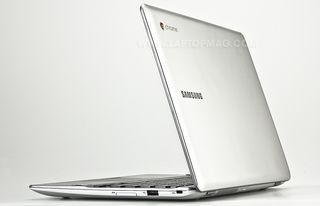
Click to EnlargeWhere last year's Samsung Chromebook had more rounded edges, the Series 5 550 is slightly more angular, and looks more like Samsung's other notebooks. Both the lid and deck are made of a silvery gray plastic, not unlike its Series 5 ultrabook. Overall, the aesthetic feels less Google-y: To be sure, the colorful Google logo is still on the lid, but it's smaller than Samsung's chrome logo.
It's not as svelte as an Ultrabook, but it's close. Weighing 3.2 pounds and measuring 11.5 x 8.5 x 0.8 inches, the Series 5 550 fits just as comfortably into a messenger bag as other ultraportables.
Heat
After streaming a Hulu video at full screen for 15 minutes, the touchpad was a very cool 77 degrees Fahrenheit, the space between the G and H keys was 89, and the middle of the underside was 90 degrees. All are well below what we consider uncomfortable -- 95 degrees.
However, the area toward the back underneath the system, near the vent, registered a highly uncomfortable 122 degrees. For an OS supposedly this light, that's disconcerting, to say the least. After an hour, even the upper right section of the keyboard became noticeably warm, too.
Keyboard
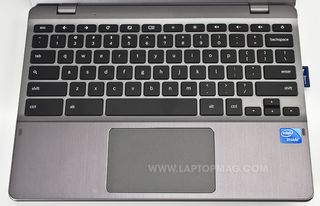
Click to EnlargeThe island-style keyboard on the Series 5 550 was plenty spacious, and the keys offered plenty of travel, more so than the Series 9 ultrabook, in fact. However, we found the keys slightly slippery, as our fingers would slide off them a little too easily. Also, there's no backlighting, but this is a sub-$500 system, so that's no great surprise.
As before, the left Caps Lock button has been replaced with a Search button. However, pressing it merely opens a new browser window. A neater trick would be for it to search not only the Web, but local files as well, a la Spotlight.
In lieu of function keys, the row above the keyboard has Chrome-specific buttons, including back, forward, refresh and full screen. Also here are buttons to control the brightness and volume
Touchpad
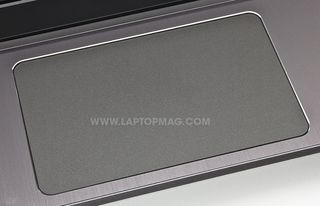
Click to EnlargeAt 4.1 x 2.5 inches, the chrome-lined clickpad on the Series 5 is plenty spacious -- larger than the first edition -- especially for a 12-inch system. While two-finger scrolling worked well, the pad lacks multitouch gestures such as pinch-to-zoom. That's a pretty disappointing ommission.
Display
The matte 12.1-inch display on the Series 5 has a resolution of 1280 x 800, the same as the previous version. With an average brightness of 314 lux, the Series 5 outshone the ultraportable average (234 lux) as well as much more expensive systems, such as the Lenovo ThinkPad X230 (240 lux).
The 1080p trailers for "Battleship" and "The Dark Knight Rises" were crisp, with bright colors and few artifacts in darker scenes. Contrast wasn't as high on notebooks with glossy displays, but it's pretty good for the price.
Audio
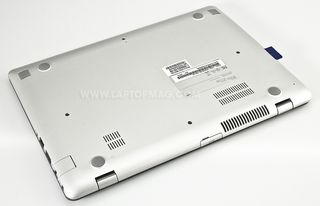
Click to EnlargeThe speakers on the bottom of the Chromebook Series 5 550 pumped out remarkably loud and good sound -- so long as the notebook was on a hard surface. While it was on our glass coffee table, streaming Bruce Springsteen's "Badlands" over Pandora rang out, with a decent amount of bass, and higher tones weren't distorted, even with the volume maxed out.
As soon as we put the notebook in our lap, though, the song sounded much more muted, with many of the higher notes hard to hear. The same pattern continued when we listened to Eminem's "Love The Way You Lie." There was just so much more definition when the laptop was on our desk.
Ports
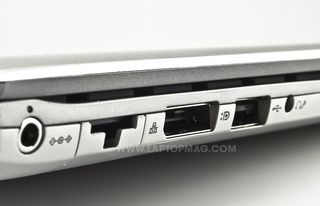
Click to EnlargeOn the left side of the Chromebook Series 5 is an Ethernet port, DisplayPort, USB, and a combo headphone/mic jack. On the right side is a second Ethernet port, a 4-in-1 card slot and a Kensington lock slot. The back side of our system also has a SIM card slot. The power jack is also on the left side; we found that you really had to push the plug in firmly, snapping it into place; otherwise, it would fall out easily.
Webcam
Over W-Fi, a Google Hangout chat produced good images on this Chromebook. While our colleague was slightly pixelated, colors were accurate, and sound stayed in sync.
User Interface
Click to EnlargeThe latest version of the Chrome OS (version 19) includes many welcome improvements. The first thing that users will notice is a bona fide desktop, and not just a browser window that fills the screen. This is welcome news not just to us, but to anyone who's familiar with Windows or Mac OS.
Along the left bottom are icons for the Chrome browser, Gmail, Google, YouTube, Google Drive and Apps. The lower right shows the time, the status of your Internet connection, battery level and a little droid icon that, when clicked, lets you adjust settings and log out or turn off the system. We like that you can pin additional apps to the Launcher, but wish you could organize their arrangement.
Any window that is opened in the main area of the desktop can be re-sized or expanded to fill the screen. We wish there was a minimize function, but it's sort of inconsequential, as everything occurs within the browser window.
When you click on the little grid icon, it minimizes the browser window, and brings up a desktop view of all your apps. It's handy to see them all in one place, but there's no way to organize them, such as rearranging their order, placing them in folders, or adding a second page. If you keep adding apps, the icons just get smaller and smaller.
Performance
Unlike the first Series 5 Chromebook, which used a 1.66-GHz dual-core Intel Atom N570 CPU, 2GB of RAM, a 16GB SSD hard drive and integrated graphics, the Series 5 550 has an Intel Celeron 867 processor, 4GB of RAM and a 16GB SSD. These kinds of components will more than suffice for browsing the Web, streaming videos and writing documents.
The Series 5 booted in a lightning-fast 12 seconds. That's half the time of most Ultrabooks, and even about five seconds faster than the MacBook Air. Windows opened quickly, and we were able to stream 1080p videos without any issues.
Compared to the original Chromebook, there's a clear boost in performance. On the Peacekeeper benchmark, the Series 5 550 scored 1,830, where the original notched just 473. The Series 5 550 took just 439.8 miliseconds to complete the Sunspider test, nearly a third of the time of the original Chromebook (1136.4 ms).
Using WebGL Aquarium, we averaged between 45 and 60 frames per second with 50 fish and all the effects turned on. That's light-years better than the first Series 5 Chromebook, which could barely manage 4 fps with just one fish, and no background or sunlight.
Offline Access and Cloud Storage
Connectivity remains the Chrome OS's Achilles heel. Without it, the Series 5 550 becomes much less useful. There are about 150 apps, including Google Mail, Docs, Google Play Books, the New York Times and "Angry Birds" that will work without an Internet connection, but considering there are tens of thousands of apps in the Chrome Web Store, it's clear that this is an OS that's only fully functional with the Web.
Google Drive, Picasa and Google Mail each give you 5GB of free cloud storage. Those who need more space can choose from one of nine different plans, which range from 25GB for $2.49 per month, to 16TB for $799 per month.
Google Drive
Chrome OS now supports a much wider range of formats, including Office files, PDF, ZIP and RAR. You can now view documents offline, though the process is a bit cumbersome. Too bad you can't edit them, and then have the changes sync automatically when Internet access is restored. However, Google says offline editing is being rolled out.
File Manager
Click to EnlargeOne of our chief complaints with the first Series 5 was that there was no easy way to view the files on the notebook itself. Google remedied that somewhat with the File Manager, which lists all your downloaded files in the browser, as well as any in an SD card or USB device. There's still no way to view system files, such as drivers, though.
Photo Editing
The built-in Photo Editor lets you make basic adjustments, such as crop, brightness, and rotate, and lets you share them with Picasa, but it's pretty anemic compared to Picasa or even Google+, both of which offer a wealth of more options, both in terms of editing and sharing.
App Selection
It's not as robust as Google Play, but the Chrome Web Store has tens of thousands of apps, according to Google. Many popular apps can be found, such as Picasa, Pandora, Netflix, "Angry Birds," NYTimes, and Tweetdeck.
Cloud Print
Click to EnlargeAs with the previous Chromebooks, users can print remotely to cloud-ready printers such as HP's ePrint line, or to older printers connected to a computer running Google Chrome.
Remote Desktop
Currently, a beta app in the Chrome Web Store, Remote Desktop lets you access a computer remotely from your Chromebook. Both must be running the Remote Desktop app in the Chrome Web browser, and both must be logged into your Google account. After that, it's a fairly easy setup process that took only a few minutes. Then, after setting up a PIN, which was used to authenticate our connection, our desktop's screen showed up in the Chrome 5's browser window.
Over the same network, there was very little lag as we typed in a word processor, and opened and closed windows and apps. However, you can view only one monitor of your remote desktop at a time, and there's no way to zoom in, so text can appear rather small.
Battery Life
The Series 5 is rated for six hours of continuous use, and 6.5 days on standby. On the LAPTOP Battery Test (web surfing via Wi-Fi with the screen at 40 percent brightness), we were down to 44 percent of our battery after four hours and 17 minutes. If we extrapolate that, it comes out to about 7.6 hours of endurance. That's very good battery life.
3G
Click to EnlargeOur version of the Series 5 550 came with a 3G option through Verizon, which comes with 100MB of free data per month. After that, the connection simply cuts off, instead of charging overage fees. At the very least, we wish it was 4G.
For those who crave everywhere-connectivity, Verizon offers an unlimited day pass for $9.99, and three monthly passes: 1GB for $20, 3GB for $35, and 5GB for $50.
Two-year contract plans include a 2GB/$30 per month, 5GB for $50 per month and 10GB for $80 per month.
Configurations
As mentioned, Samsung offers two versions of the Series 5 550. Our model, which has a 1.3-GHz Intel Celeron 867 processor, 4GB of RAM and a 16GB SSD, as well as a 3G radio, costs $549. The non-3G version, which otherwise has the same specs, costs $449.
Verdict
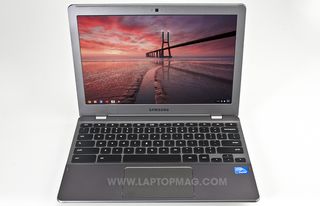
Click to EnlargeThere's no doubt that the Chrome OS has improved by leaps and bounds. And Samsung's Chromebook Series 5 550 is a pretty slick vehicle for the platform, especially for those who have basic needs. The comfortable keyboard and bright screen are as good as what you'll find on some Ultrabooks, and this machine is certainly faster than its predecessor. However, $449 is a lot to spend on a machine that has limited offline capability.
While it's a different breed of laptop, it's hard to justify spending this much dough on an ultraportable with a Celeron processor and just 16GB of storage when you can get a Dell Inspiron 14z with a second-gen Intel Core i3 processor and a 500GB hard drive for the same price. If the price drops, the Chromebook Series 5 550 will be worthy of stronger consideration, but right now we wouldn't choose this clamshell over a traditional notebook or the iPad.
Samsung Series 5 550 Chromebook Specs
| Brand | Samsung |
| CPU | 1.3-GHz Intel Celeron 867 |
| Card Slots | 4-1 card reader |
| Company Website | www.samsung.com |
| Display Size | 12.1 |
| Graphics Card | Intel HD Graphics 3000 |
| Hard Drive Size | 16GB |
| Hard Drive Speed | n/a |
| Hard Drive Type | SSD Drive |
| Mobile Broadband | Verizon EV-DO Rev A |
| Native Resolution | 1280x800 |
| Operating System | Google Chrome |
| Optical Drive | None |
| Optical Drive Speed | n/a |
| Ports (excluding USB) | Kensington Lock, Ethernet, DisplayPort, Combo Headphone/Mic Jack |
| RAM | 4GB |
| RAM Upgradable to | 4GB |
| Size | 11.5 x 8.5 x 0.8 inches |
| Touchpad Size | 4.1 x 2.5 inches |
| USB Ports | 2 |
| Video Memory | Shared |
| Weight | 3.2 pounds |
| Wi-Fi | 802.11a/b/g/n |
